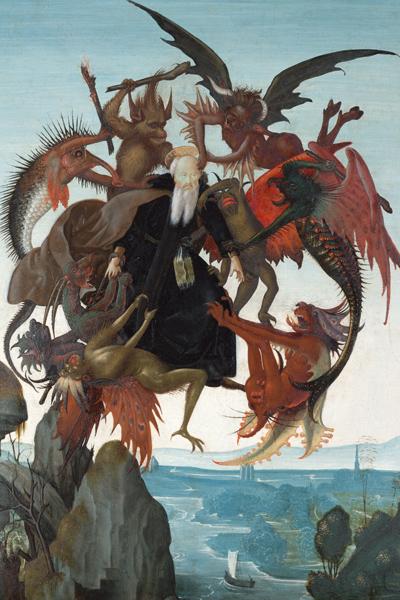William James considered an hallucination to be ‘as good and true a sensation as if there were a real object there’, except that the ‘object happens to be not there, that is all’ — an admirable definition, and a favourite of Oliver Sacks, the eminent neurologist, who has written what he calls ‘a sort of natural history or anthology of hallucinations’, which he thinks are an essential part of the human condition.
He excludes schizophrenic hallucinations, on the grounds that they demand separate consideration, but includes every other kind. Some are induced by sensory deprivation, such as isolation and darkness — ‘the prisoner’s cinema’ — or visual monotony, as experienced by sailors gazing on a becalmed sea, or by travellers in deserts or polar regions. Mushers in the Iditarod dog-sled race, for example, who go for as long as a fortnight on minimum sleep, often hallucinate trains, orchestras and strange animals.
By similar compensatory processes, the blind often ‘see’ things, while the deaf ‘hear’ them, especially music. Those suffering from anosmia, or loss of smell, sometimes hallucinate smells — as did the protagonist of Sacks’ book The Man Who Mistook His Wife for a Hat — and amputees experience phantom limbs. Nelson regarded his phantom arm as ‘a direct proof for the existence of the soul’.
Sacks had his own experience of this in 1974, when he injured his left leg in a mountaineering accident, and also suffered neuromuscular damage, so for a while it disappeared from his body image; he wrote a book about it, A Leg to Stand On. Many bereaved people ‘see’ their loved ones, while other hallucinations are associated with violent death and guilt, such as Hamlet’s ghost (‘In my mind’s eye, Horatio’) and Macbeth’s dagger.
Hypnagogic hallucinations, which are distinct from dreams, tend to appear just before sleep, and probably happen to most people, though they can be so subtle as to be hardly noticeable. They were prized by Edgar Allan Poe, who used them in his poems and stories, and by his great translator Baudelaire. Nabokov’s were of course uncommonly beautiful: ‘grey figures walking between beehives, or small black parrots gradually vanishing among mountain snows, or a mauve remoteness melting beyond moving masts’.
Hypnopompic hallucinations, which may come on waking, are quite different in character, seen with open eyes in the light, rather than with closed ones in darkness, and are far less common; confusingly, some people have hypnagogic hallucinations on awakening, and hypnopompic ones while falling asleep.
Other hallucinations are caused by illness, such as Parkinsonism, especially in conjunction with the drug L-dopa; various kinds of delirium, as in Evelyn Waugh’s The Ordeal of Gilbert Pinfold; the ecstatic seizures of epilepsy — Sacks conjectures that Joan of Arc ‘may have had temporal lobe epilepsy with ecstatic auras’; and migraine. Migraine-like patterns can be found in Islamic art, Acoma pottery, Swazi basketry and Aboriginal bark painting, and Sacks wonders if such arabesques and hexagons, ‘built into our brain organisation, provide us with our first intimations of formal beauty’.
Hallucinogenic drugs have been used in every culture known to us, often sacramentally, and have been investigated — and augmented — by scientists. Daniel Breslaw, one of the subjects in a study of LSD at Columbia University in the 1960s, experienced vivid synaesthesia: ‘One knows the smell of a low B flat, the sound of green, the taste of the categorical imperative (which is something like veal).’
As a young doctor in California, Sacks himself tried a drug called Artane and had a conversation about analytic philosophy with a spider that had a voice like Bertrand Russell; he later told the story to an entomologist friend, who nodded sagely and said: ‘Yes, I know the species.’ One sunny day in 1964, hoping to see ‘true’ indigo, he ‘developed a pharmaceutical launchpad consisting of a base of amphetamine (for general arousal), LSD (for hallucinogenic intensity), and a touch of cannabis (for a little added delirium)’, and looked at a white wall, on which there appeared ‘a huge, trembling, pear-shaped blob of the purest indigo’. And the next year in London, after reading Froissart’s Chronicles and Henry V, he injected morphine and watched the battle of Agincourt on the sleeve of his dressing gown.
Sacks writes in the great tradition of literary doctors. He is humane, relaxed and amused, and loves a good anecdote — so he includes the condition of cataplexy, the sudden and complete loss of muscle tone with emotion or laughter (hardly an hallucination), just so he can mention that a friend of the comedian Robin Williams told him that whenever he met Williams he would lie down preemptively, rather than fall down laughing. He is not much given to speculation, but writes that ‘one must wonder to what extent hallucinatory experiences have given rise to our art, folklore, and even religion’.






Comments